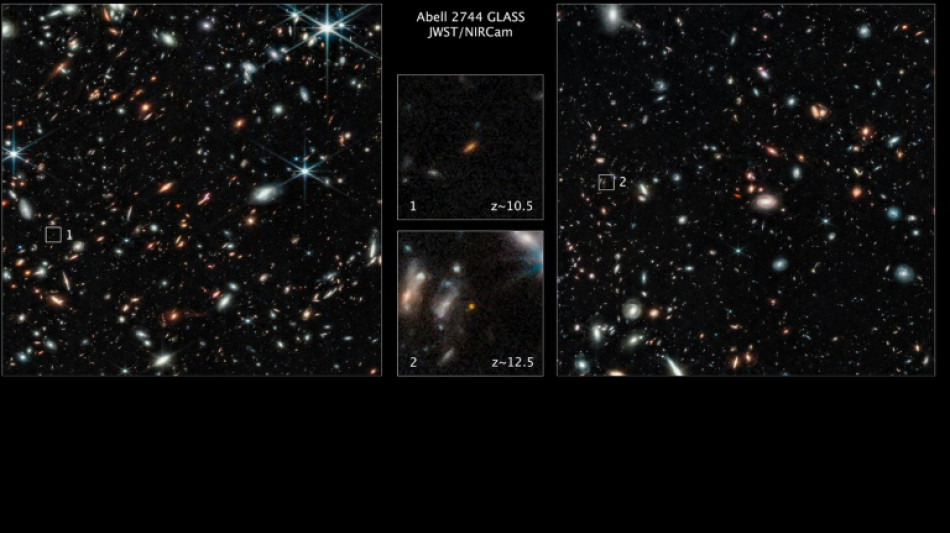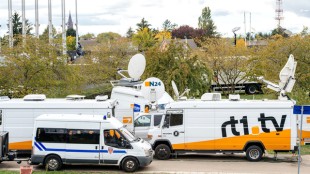
-
 Japan's Fast Retailing raises profit forecast after China growth
Japan's Fast Retailing raises profit forecast after China growth
-
Olympic champion Zheng out of Australian Open

-
 England's Brook 'deeply sorry' for nightclub fracas
England's Brook 'deeply sorry' for nightclub fracas
-
New clashes in Iran as opposition urges more protests

-
 Equity markets mostly down as traders eye US jobs data
Equity markets mostly down as traders eye US jobs data
-
England cricket board launches immediate review into Ashes debacle

-
 Dancing isn't enough: industry pushes for practical robots
Dancing isn't enough: industry pushes for practical robots
-
Asian markets mostly down as traders eye US jobs data

-
 Australia to hold royal commission inquiry into Bondi Beach shooting
Australia to hold royal commission inquiry into Bondi Beach shooting
-
Sabalenka accuses tour chiefs over 'insane' tennis schedule

-
 Cambodia to liquidate bank founded by accused scam boss
Cambodia to liquidate bank founded by accused scam boss
-
Farmers enter Paris on tractors in protest at trade deal

-
 Viral 'Chinese Trump' wins laughs on both sides of Pacific
Viral 'Chinese Trump' wins laughs on both sides of Pacific
-
Stokes vows to stay on but 'wrongs to put right' after crushing Ashes defeat

-
 Lidl to drop broadcast TV ads in France
Lidl to drop broadcast TV ads in France
-
Stokes admits 'wrongs to put right' after crushing Ashes defeat

-
 Sabalenka impresses again in Australian Open warm-up, vows more to come
Sabalenka impresses again in Australian Open warm-up, vows more to come
-
Gilgeous-Alexander to the rescue as Thunder sink Jazz in overtime

-
 From Diaz to 'Mazadona' - five new faces starring at AFCON
From Diaz to 'Mazadona' - five new faces starring at AFCON
-
Startups go public in litmus test for Chinese AI

-
 Death of Bazball: Five things we learned from Ashes series
Death of Bazball: Five things we learned from Ashes series
-
Australia's emotional Khawaja bows out for final time with Ashes win

-
 Asian markets mixed as traders eye US jobs data
Asian markets mixed as traders eye US jobs data
-
Australia win final Test to complete 4-1 Ashes triumph over England

-
 Trump withdraws US from key climate treaty, deepening global pullback
Trump withdraws US from key climate treaty, deepening global pullback
-
Trump pulls US out of key climate treaty, deepening global pullback

-
 Morocco under huge pressure as hosts face Cup of Nations heat
Morocco under huge pressure as hosts face Cup of Nations heat
-
Australia heatwave stokes risk of catastrophic bushfires

-
 Australia 71-2 at lunch, need 89 more to win final Ashes Test
Australia 71-2 at lunch, need 89 more to win final Ashes Test
-
Study shows how fast kilos return after ending weight-loss drugs

-
 Trump pulls US out of key climate treaty, science body: White House
Trump pulls US out of key climate treaty, science body: White House
-
England all out for 342, set Australia 160 to win final Ashes Test

-
 Silver Range Provides an Operational Update
Silver Range Provides an Operational Update
-
Zenwork Joins the National Association of Computerized Tax Processors (NACTP)

-
 Kee Ming Group Berhad Inks Underwriting Agreement With TA Securities Ahead Of ACE Market IPO
Kee Ming Group Berhad Inks Underwriting Agreement With TA Securities Ahead Of ACE Market IPO
-
Market Logic Announces Technology Partnership with Zappi to Accelerate Innovation with AI

-
 Just - Evotec Biologics Receives Grant for AI-Driven Optimization of Monoclonal Antibody Developability for Affordable Access
Just - Evotec Biologics Receives Grant for AI-Driven Optimization of Monoclonal Antibody Developability for Affordable Access
-
Lighthouse Names Georg Beyschlag Chief Financial Officer as Company Scales for Next Phase of Global Growth

-
 Storm in a tea cup for Frank as pressure mounts on Spurs boss
Storm in a tea cup for Frank as pressure mounts on Spurs boss
-
Sesko spark masks Man Utd disappointment for Fletcher

-
 Venezuelan opposition blindsided by Trump, waiting it out
Venezuelan opposition blindsided by Trump, waiting it out
-
Guardiola downbeat about Man City's faltering title bid

-
 City, Villa falter in Premier League title race
City, Villa falter in Premier League title race
-
Trump has options in Greenland, but provocation may be the point

-
 Sesko double not enough as Man Utd stumble at Burnley
Sesko double not enough as Man Utd stumble at Burnley
-
Semenyo stuns Spurs to leave Frank under fire

-
 Inter extend Serie A lead at Parma after Napoli slip
Inter extend Serie A lead at Parma after Napoli slip
-
US stocks retreat from records as oil falls further

-
 City stumble again in title race as Villa held
City stumble again in title race as Villa held
-
Man City title bid damaged by Brighton draw despite Haaland's 150th goal


Webb observations point to a shorter cosmic dark age
The first galaxies may have formed far earlier than previously thought, according to observations from the James Webb Space Telescope that are reshaping astronomers' understanding of the early universe.
Researchers using the powerful observatory have now published papers in the journal Astrophysical Journal Letters, documenting two exceptionally bright, exceptionally distant galaxies, based on data gathered within the first few days of Webb going operational in July.
Their extreme luminosity points to two intriguing possibilities, astronomers on a NASA press call said Thursday.
The first is that these galaxies are very massive, with lots of low-mass stars like galaxies today, and had to start forming 100 million years after the Big Bang which occurred 13.8 billion years ago.
That is 100 million years earlier than the currently held end of the so-called cosmic dark age, when the universe contained only gas and dark matter.
A second possibility is that they are made up of "Population III" stars, which have never been observed but are theorized to have been made of only helium and hydrogen, before heavier elements existed.
Because these stars burned so brightly at extreme temperatures, galaxies made of them would not need to be as massive to account for the brightness seen by Webb, and could have started forming later.
"We are seeing such bright, such luminous galaxies at this early time, that we're really uncertain about what is happening here," Garth Illingworth of the University of California at Santa Cruz told reporters.
The galaxies' rapid discovery also defied expectations that Webb would need to survey a much larger volume of space to find such galaxies.
"It's sort of a bit of a surprise that there are so many that formed so early," added astrophysicist Jeyhan Kartaltepe of the Rochester Institute of Technology.
- Most distant starlight -
The two galaxies were found to have definitely existed approximately 450 and 350 million years after the Big Bang.
The second of these, called GLASS-z12, now represents the most distant starlight ever seen.
The more distant objects are from us, the longer it takes for their light to reach us, and so to gaze at the distant universe is to see into the deep past.
As these galaxies are so distant from Earth, by the time their light reaches us, it has been stretched by the expansion of the universe and shifted to the infrared region of the light spectrum.
Webb can detect infrared light at a far higher resolution than any instrument before it.
Illingworth, who co-authored the paper on GLASS-z12, told AFP disentangling the two competing hypotheses would be a "real challenge," though the Population III idea was more appealing to him, as it would not require upending existing cosmological models.
Teams are hoping to soon use Webb's powerful spectrograph instruments -- which analyze the light from objects to reveal their detailed properties -- to confirm the galaxies' distance, and better understand their composition.
The Atacama Large Millimeter/submillimeter Array (ALMA), a ground telescope in northern Chile, might also be able to help in weighing the mass of the two galaxies, which would help decide between the two hypotheses.
"JWST has opened up a new frontier, bringing us closer to understanding how it all began," summed up Tommaso Treu of the University of California at Los Angeles, principal investigator on one of the Webb programs.
P.Mathewson--AMWN
